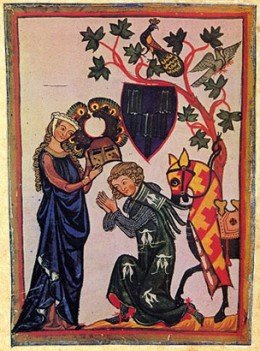Englishization of Petrarchan Convention: Sidney’s Sonnets

In Philip Sidney’s sonnet sequence Astrophil and Stella (1591), the names Astrophil and Stella mean Star-lover and star, suggesting the impossibility of their union because of the distance between them. Philip Sidney draws from the Petrarchan idea of the unattainable beloved and the pining lover trying to woo her. The beloved is held at a higher pedestal and seen as closer to god, and thus closer to Ultimate Beauty (as in Neo-platonism). We also find an autobiographical element in the sequence wherein Stella, the unattainable beloved, is supposedly inspired from Sidney’s beloved Penelope who was married to another man. Ergo, Stella embodies the unattainable Penelope and Astrophil embodies Sidney, the servile lover. However, Novy Kapadia in Sidney: Introduction points out that some critics maintain that Sidney was not actually in love with Stella because “the sequence displays detachment from the realities of ordinary passion.” This being said, Sidney’s Astrophil and Stella has been acclaimed for its “adaptation of Petrarchanism” and “erotic, poetic, political, religious, [and] cultural” articulation according to Gary Waller in Three Sidneys-Philip, Mary and Robert. In this essay, I shall attempt to analyse Sidney’s Astrophil and Stella in contrast with the Petrarchan sonnet convention.
Like Petrarch, Sidney also writes in the sonnet form and is in fact credited by many critics for bringing the Petrarchan form to English tradition. The Petrarchan sonnet form, traditionally is comprised of fourteen lines where an octave (8 lines) is combined with a sestet (6 lines). The octave (the first 8 lines) typically introduces the theme or problem using a rhyme scheme of abba abba. The sestet (the last 6 lines) provides resolution for the poem and rhymes variously, but usually follows the schemes of cdecde or cdccdc. Francesco Petrarca mostly used the Iambic Pentameter in his sonnets, which was later adopted by Shakespeare. Sidney’s sonnets are written in a variety of rhyme schemes and his meter varies between Iambic Pentameter and Iambic Hexameter (Alexandrines). His sonnets also comprise of fourteen lines with an octave and a sestet but are further divided according to the rhyme scheme. The octave is broken down into lines of four and four and the sestet can either be further divided into lines of four and two or two, two and two, where the last two lines may represent a shift in theme such as in Sonnet XXVII. Another similarity between Petrarch and Sidney is the use of alliteration which flows through the works of both poets.
Both poets use the theme of the freedom-servitude paradox. This theme runs on the basic principle that serving the beloved gives meaning to the life of the lover, “confirmed his worth and honour and proved their nobility and identity. So the service is seen as both liberating and a trap”, as stated by Kapadia. Wyatt also uses this paradox in his sonnets. The imagery of prisons and bondage is used by both Petrarch and Sidney to highlight the fact that the service of the lady does not always lead to rewards, and can also lead to the loss of liberty. In his Sonnet II, Sidney describes the bondage that love causes, “Now even that footstep of lost liberty / Is gone”. Kapadia also points out that there is a convergence of courtly and Petrarchan love as the honour of Courtly love and feudal obligations combine in Sidney’s poetry. While wooing Stella, Sidney’s poetry is also trying to please Queen Elizabeth and the courtiers in order to gain favours and appreciation as in Sonnet XXXIV, “Art not asham’d to publish thy disease?… What idler thing than to speak and not be heard?” Thus, Stella is not only compared to god (through Neo-platonism) but also the Queen. Anthony Low in The Reinvention of Love writes, “If a man is faithful to the worthy object of his desire, even to the end, he wins victory from apparent defeat.” In reality, Sidney was unable to please the Queen or Stella and his failure is a deviation from Petrarch. Anthony Low in Sir Philip Sidney: “huge desire” states, “[Sidney] mourns the hopeless failure of all his worldly desires, which centered on the figure of the Queen who has now rejected and disgraced him”. Although, there is one instance when Stella expresses her attraction for Sidney, but remains bound by honour as she is a married woman.
There emerges a parallel between Petratch and Sidney in their objects of desire i.e. their beloved. The love poetry of Petrarch is a primary theme running throughout the Sidney’s sonnet sequence. Petrarch’s love and description of Laura in the 366 poems Canzoniere are closely mirrored in Astrophil’s love and description of Stella. Petrarch’s preoccupation with Laura causes his overwhelming joy as well as tormenting desires, the same conflict that Astrophil experiences for Stella. Both the poets follow the traditional male-dominant discourse and as a consequence, the beloved is portrayed as a meek character expected to submit to the desires of the poets (and patriarchy). Critics argue that Stella is entirely the product of her lover’s consciousness, “Sidney’s sonnets provide a theatre of desire in which the man has all the active roles, and in which the woman is silent or merely iconic, most present when she refuses him, or is absent” says Waller. We do not witness the expression of Stella’s feelings except once in Song 8, and even then only in Astrophil’s words or male voice (unlike Petrarch who does not allow for even so much for his Laura). Stella’s silence can be viewed as the repression of her character, typical to the socio-cultural norms.
Sidney is socially ambitious, “Oft turning others’ leaves, to see if thence would flow” (Sonnet I). Here he says he studies others’ work to see if he can outdo them. Later it is implied that the better poet he shall be, the more impressed Stella will be. Therefore, for impressing Stella he must impress the courtiers and Queen Elizabeth and we witness the public and private spheres merging together. Philip Sidney, revised the Petrarchan convention in relation to the Tudor court politics, which makes the background of his poems. Wyatt and Sidney employ the Petrarchan convention in order to explain and understand their political careers. At the heart of their use of Petrarchan convention lies the patronage system as the means of distributing power in Tudor politics. Wyatt and Sidney apparently discard politics and choose to write the Petrarchan love poems, however, their lyrics still reflect their political careers. The theme of self-praise also emanates from Sidney’s sonnets conforming to Petrarchan convention as in Sidney’s Sonnet I, “Biting my truand pen, beating myself for spite”. Sidney highlights the perfection of his poetry while he credits Stella, his muse, “’Fool,’ said my Muse to me, ‘look in thy heart and write.’” Further he also blames her for any imperfections or creative blocks that he might suffer. In this blame he deviates from Petrarchan convention.
The most significant deviation from Petrarchan convention lies in the religious beliefs of Sidney. Sidney followed the Protestant ideology of love and marriage, whereby men and women were equals and sexual desires weren’t considered to be sinful. For Sidney, the sexual desires of men did not affect their political stature. Whereas, according Catholicism, women were supposed to uphold the ideals of chastity and were termed as “whores” if they were to express carnal desires (specially for men who were not their husbands). Protestantism was a more lenient religion which even allowed Sidney to pursue a married woman, who in fact enjoyed being chased. This also brings out the element of masochism in both Astrophil and Stella who could not materialize their desire for one another, yet kept up the pursuit. Petrarch, as a Catholic, does not sanction sex in his poetry whereas Sidney accepts his sexual desires through Astrophil in his poetry. Spencer carries forward this idea and aims to achieve a union with god by the means of sexual consummation with his beloved. Sidney discusses similar ideals about sexual consummation in his Defense of Poesy (1595) as well. In the essay, Sidney also defends the use of imagination to invoke pity in his beloved, much like Petrarch.

Petrarch uses the concept of self-fashioning to earn success artistic success and by extension, professional success. Similarly, in Sonnet V, Sidney also accepts that in courtly love and politics, one must “carve” themselves according to their environment in order to succeed in love and in career. This theme is reminiscent of the ideals posited by Niccolo Machiavelli in The Prince (1532). In Sonnet XLV Sidney writes, “I am not I: pity the tale of me” invoking pity from the court, in accord with his self-fashioned public image. This echoes the words of Shakespeare’s Machiavellian villain Iago from Othello, “I am not what I am” (1.1). Though Sidney pretends not to be interested in politics, Astrophil’s courtship of Stella echoes Elizabethan court politics, which applied the Petrarchan love convention to the relationship between Elizabeth and her male courtiers. “Through contrasting the affinity and dissimilarity between Elizabeth and Stella, Sidney gains an insight into court politics, in which he never was honored by the queen” as expressed in The Petrarchan convention and Tudor court politics in poetry of Thomas Wyatt and Philip Sidney by Sook Hong from Marquette University.
Petrarch’s Canzoniere introduces an intensity and inwardness of feeling and perception formerly unknown in European poetry; and, in its own way, so does Sidney’s Astrophil and Stella. Both the Canzoniere and the sonnet sequence Astrophil and Stella weave together romance, pathos, sensuality, passion and Neo-Platonic love. As readers of Sidney and Petrarch, we are deeply struck by the similarities and constant allusions between these poet’s writings. Sidney’s very first sonnet says, “And fain verse my love to show, That she, dear she, might take pleasure of my pain… Reading might make her know, Knowledge might pity win, and pity grace obtain” (Sonnet I). It is a typically Elizabethan sonnet in that it presents us with a hierarchical order: from pity to reading to knowledge to grace. And Petrarch’s first canzone depicts the same hierarchy. Abraham Avendaño Martínez in Sidney and Petrarch The Contemplation of Love brings to our notice that “The similarities are striking altogether; both the sonnet and Petrarch’s rima are the impassioned expressions of inner feelings. The poetic voices make clear that they both want to gain the lady’s pity and affection through the use of poetry: “And fain verse my love to show” and “del vario stile in ch’io piango et ragiono.”” The relationship between Astrophil and Stella, thus, is found to be very much alike to that between Petrarch and his muse Laura. However, some critics are of the view that Sidney is actually questioning the Petrarchan convention by depicting a poetic persona that is much too similar to Petrarch’s, and hence deviating from Petrarchan convention. Throughout the Canzoniere and the cycle of sonnets, the different stages of a love relationship are built up: from its starting point in the lover’s attraction to the lady’s beauty, through various trials, throes and pangs, to a conclusion in which love more or less comes to nothing.